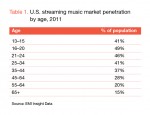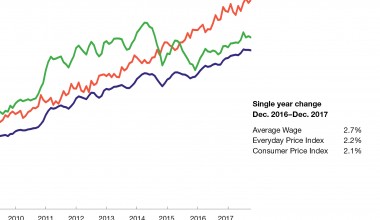Innovation’s Double Sword: Four Case Studies
Over the past year, I’ve had the opportunity to supervise four college students from local colleges who interned at AIER. Under my supervision, each of them identified, analyzed, and reported on a key innovation in a specific industry.
Innovation is a critical element contributing to economic development in a dynamic economy. Innovations helped move the U.S. from an agricultural to an industrialized economy and now toward a digital and information economy. Along the way, as new industries and jobs developed, old ones faded away, wealth was created, and day-to-day life changed for many people.
But as our interns discovered, not all changes due to innovation are good. For example, one intern found that while the innovation she studied—online ad tracking—made life far more convenient for users of the technology, the innovation also created a filter bubble, or limited exposure to new and different information.
It is critical for economists to observe, measure, and understand changes in the economy. One of the most valuable services AIER provides to the public is helping to develop economic thought, particularly within the educational process. Working with high school and college students is a particularly gratifying experience for me as a senior research fellow and for AIER as a nonprofit economic research institute.
Our student interns examined four areas of innovation in our economy—hydraulic fracking, collateralized mortgage obligations, online behavioral advertising, and digital streaming in the music industry. Here are excerpts from their papers about what they learned.
—Robert Hughes
Innovation 1
Hydraulic fracturing to extract natural gas and petroleum trapped in the pores of a rock formation known as shale
By Kevin Deptula
Junior math and economics major, Williams College
“While innovation is generally thought of as a positive, it is important to recognize the negative effects it might have as well. Fracking created increases in real income and employment in the short term, but this short-term improvement may pave the way for long-term struggles.”
For nearly a decade after 1990, U.S. oil production experienced a steady decline. However, starting around 2009, it began to increase dramatically. Fears of U.S. dependence on foreign energy were dismissed as the U.S. became the largest oil producer in the world.
Why did fracking just recently take on a role of such importance? The answer is two-fold. First, the technology was not pioneered until the late 1990s. The story goes that George Mitchell and other workers at Mitchell Energy first successfully used commercial fracking in 1998 at the Barnett Shale in Texas. The fracking boom, however, did not begin until almost ten years after Mitchell’s pioneering success.
The other half of the story involves oil prices. Fracking has a higher break-even price than traditional drilling (many typical traditional drillers have a break-even price around $10 a barrel compared with about $30 a barrel for fracking). Oil prices may have been too low in the 1990s to profit from fracking. In 1998, they hovered around $17 a barrel. Prices rose over the next 10 years to a peak of $145 a barrel. Of course, they fell with the onset of the Great Recession, but the trough was short-lived, and oil prices quickly rebounded and spent the first half of the 2010s hovering in the $80–100 range. These high oil prices resulted in the possibility of profitable fracking.
Oil prices have been significantly lower for the past two years. Do these low oil prices make fracking unprofitable, and will fracking cease to have such a large role in the oil industry? This is unclear. However, what is clear is that right now, about half of U.S. oil production and a very significant portion of U.S. natural gas production come from shale. It is a development of consequence, and as such, the economic effects of fracking should be examined.
Effect on local economies
Two prominent areas of fracking were examined: the Bakken region (most of North Dakota) and the Marcellus (parts of West Virginia, Pennsylvania, and New York). In the Bakken region, one study found, income per capita grew faster than the state average in six of seven selected counties. In the Marcellus region, it grew faster in all six selected counties. Most of the differentiation occurred between 2010 and 2012, the peak years of the fracking boom.
However, there is a substantial amount of literature that questions whether these fracking booms equate to a sort of “Dutch disease,” or resource curse, ultimately harming the counties in the long run. Perhaps the fracking industry can offer higher wages, effectively diminishing the labor forces of other industries. Then, when the fracking boom ends, the boomtowns are left with neither the fracking industry nor other industries.
Effect on other energy sources
Since natural gas costs much more to transport than oil, its markets are regional. Oil, on the other hand, is easy to transport, so oil prices are relatively consistent around the globe. The discovery of new oil might bring the price down, but only by a small amount due to the large global supply. Fracking has increased the supply of natural gas. According to the Congressional Budget Office, “If shale gas did not exist, the price of natural gas would be about 70 percent higher than currently projected by 2040.” Cost-conscious consumers may now be able to save by switching from coal to natural gas. While it is difficult to attribute how much of coal’s decline is a byproduct of the growth of natural gas and how much is due to increased governmental regulations, multiple reputable sources give credence to both explanations.
One concern about the increase in fracking is that renewable energy development will suffer. As fracking provides cheap natural gas and more accessible petroleum, the incentive to invest in renewable energy may diminish.
Effect on government revenues
Another outcome of the fracking boom has been a surge in state taxes, such as in North Dakota, where tax collection related to fracking more than tripled between 2006 and 2014. While the increased revenue allowed North Dakota to slash income taxes and increase public investment, it was a potentially unreliable source. As fracking in North Dakota has slowed in the past year, tax revenues have fallen, setting in motion a series of budget cuts to handle the loss.
Overall, while innovation may be a net positive, it is important to note that it creates both winners and losers.
Innovation 2
Collateralized mortgage obligations, investment securities built on mortgage loans
By Rhett Maiorana
First-year graduate student in economics, Bard College
“Although improperly structured, understood, and excessively risky collateralized mortgage obligations caused the financial crisis, there is no reason that appropriate safeguards cannot prevent the next crisis and ensure that only beneficial CMOs compose most of the market.”
The CMO market has tremendous sway over the performance of the U.S. and even global economy. For that reason, the motivation for researching this innovative financial instrument lies in better understanding how such an immense and important market functions.
Essentially, a CMO is merely an investment that involves the securitization of mortgage loans. Although bankers have been selling mortgage loans since the 1850s, a viable secondary market for mortgages did not exist until around the 1930s with the formation of Fannie Mae, to improve housing finance and make home ownership more accessible. This New Deal, government-backed agency ushered in a burgeoning secondary market for mortgage loans and brought about the birth of the long-term, fixed-rate mortgage—a unique invention, globally and historically speaking. By 1968, Congress simultaneously privatized Fannie Mae and created Ginnie Mae, which was given a similar mission to increase liquidity in the secondary mortgage market. In 1970, Freddie Mac was set up to introduce some competition.
Securitization emerged in the 1970s when home mortgages were pooled by government-sponsored enterprises. In 1970 Ginnie Mae paved the way for government-backed agencies in issuing mortgage-backed securities, offering an MBS issue with a face value of $70 million. It had a “pass-through” financial structure in which income from interest and principal payments flowed directly to the security’s investor, straight through the servicer and issuer of the security. The first multiclass MBS, or CMO, debuted in 1983. A CMO, in contrast to a pass-through structure, is composed of several tranches, which allow investors to choose from a wider selection of payoff patterns, ranging from lower risk coupled with lower returns, to high risk but higher returns.
Private-label, or non-government-backed CMOs, were first issued in the mid-to-late 1990s, and their market soon experienced exponential growth. In 1996, total MBS issuances were below $500 million. By 1998, the total had more than doubled, to $1 trillion, and by 2003 it reached an all-time high of $3.6 trillion before leveling out. By 2008, private-label issuance was a shadow of its former size, at $45 million. While total CMO issuances recovered to a sizable $2 trillion for 2009, non-agency, or private, offerings languished at a meager $30 million.
During the climax of the securitization business, some of the largest CMOs were crafted with anywhere from 40 to 50 distinct tranches, ranging from senior tranches rated AAA, meaning they were most protected from credit losses, to riskier, lower-rated subordinate tranches and residual-class investors who could have no claim on the collateral until all obligations to the more senior classes were fully met.
Impact on the economy
Under the securitization paradigm, lending no longer constitutes the end-point of the allocation of funds but is only the beginning of an intricate process where loans are sold in order to be aggregated and packaged into multiple securities with varying degrees of risk and return, which, in turn, may be the inputs of further securitization. As a result, the traditional model of banking, which had centered on banks playing the many roles needed to guarantee an efficient match between supply and demand for funds, has been replaced with a decentralized model. The CMO has given rise to the indirect participation of pension funds, insurance companies, and hedge funds in the mortgage market. The rise of CMOS also led to the appearance of new participants in the mortgage system replacing small banks and thrifts, including (before the housing crisis), firms such as New Century and Countrywide.
One of the other consequences was the seeming change in the behavior of economic agents. Among these changes, mortgage brokers who originated the loans often did not make a strong effort to evaluate whether a borrower could pay off a loan, since the originator planned to quickly sell the loans to investors in the form of mortgage-backed securities. Research strongly implies this contributed to the deterioration of underwriting standards.
Pros and cons of CMOs
The CMO market has led to increased sophistication in the system of financial intermediation.
One of its positive impacts is the greater selection of investments of varying risk and return, in addition to the ability to diversify risk.
Has the CMO market reduced the cost of housing finance? The research is unsettled. CMOs were created to realize the objective of reducing the cost of home ownership by creating a more liquid mortgage market. However, recent studies indicate that the savings most likely lie in lower mortgage loan origination fees (which help consumers); they also find that securitization does not lower mortgage yields. At the same time, many authors have found that CMOs and pass-through securities have an indistinguishable effect on both mortgage rates and origination fees. Further, in 1969, the year prior to the first government- backed MBS, the rate of owner-occupied homes in the U.S. stood at 64.3 percent. As of 1993, the rate stood at 64 percent, growing to 69 percent in 2005–2006 before dropping to 67 percent in 2009.
Another crucial question is, what role, if any, did CMOs play in the run-up and subsequent decline of home prices during the decade of the 2000s? Like so much else, the answer to this is fiercely debated. The “toxic assets” derived from subprime loans were the ultimate contributors to the housing crisis. There is much blame to go around, among borrowers, originators, and rating agencies.
Innovation 3
Online behavioral advertising, soon to surpass TV ads in revenue
By Whitney Harris
Sophomore economics major
Bard College at Simon’s Rock
“Virtually anyone can make a profit online so long as their content is clicked on. Additionally, a creator can earn a living online if they can garner some sort of steady viewership. This provides for what seems to be a more democratized system for dissemination of information.”
The technology for online behavioral advertising, often referred to as “ad tracking,” was invented in 1995, early in the history of consumer internet usage. Its implementation is more recent: Google started using data points to better equip its results in 2009. Since 2009, there has been no such thing as a “standard Google search.” Search engines like Google consider everything from past searches and browsing history to what a computer user owns and what their contacts are searching for.
Online advertising revenue in the U.S. amounted to $59.6 billion in 2015, or an estimated .33 percent of gross domestic product. For 2016, revenues are estimated to be $72 billion, and online ad revenue is predicted to surpass that of television by 2018. Online ads largely consist of retail ads, which make up 22 percent of revenues. They have the most immediate effect on purchases: A consumer can see, click on, and make a purchase because of an ad in minutes, if not seconds.
Social impact of online ads
Online behavioral tracking increases internet consumer satisfaction by showing a consumer what they want to see—often only what they want to see, which has been described as a “filter bubble,” similar in attributes to an economic bubble in three ways: Online behavioral tracking increases the profitability of internet ads, displacing other ads. Online ad revenues grow faster—a boom—than other forms of media, and they can lead to euphoria, creating a positive feeling in the user and reaffirming their behavior.
The personalized media experience created by behavioral tracking is unavailable from other forms of media. Web-based media companies interrupt previous conceptions that one must be associated with a large company or have an agent to make a profit in entertainment or media. Online behavioral advertising provides opportunity for everyone to make a profit and therefore incentivizes new creators. It plays a key role in the internet’s emergence as a growing medium.
The internet’s vastness allows for a much narrower casting of information, in contrast to the broadcasting of previous media, where a single message was uniformly distributed to a large group of people. Instead of being exposed to three or four different stories, an internet consumer can delve into articles, videos, blogs, and tweets about a topic that interests them – and can ignore topics that do not. The success of the internet can largely be attributed to this: It is an immersive experience that allows the consumer to be exposed to information on an individualized basis. Online behavioral tracking fosters this. While this is good for business—it gets consumers to continue consuming the information they like—it is not as good for creating an informed populace.
Economic impact
Online behavioral tracking’s impact is difficult to measure numerically. Figures for total revenue, market share, percent of GDP, and number of competitors do not fully capture it. The growth of online advertising is one of an entirely different type of dissemination and information. Its ultimate social consequences invite a questioning of the above metrics as effective means to determine the merit of an innovation and the consequences of online communications’ superseding other types of media.
Innovation 4
The effect of streaming on the music industry
By Jacob Broude
Junior economics major, Williams College
“Physical sales and conventional ways of distributing music have become less popular over the past decade, giving the music industry little choice but to pivot into the technological sector.”
Digitalization has taken over the music industry, allowing ordinary people to have unlimited access to music wherever there is access to the web or cell service. This new age has come about through the innovation of streaming, which allows the user to access music without downloading it. The first example of internet streaming occurred in 1995 when RealAudio launched its service. However, it took until 2003 for online music to take off when Apple launched iTunes. Following that popularization of digital music, streaming companies and products flooded the industry. Streaming companies were responsible for revenues of $2.4 billion in 2015, a 34 percent market share of the U.S. music industry.
Streaming is the medium of the future. Streaming services are becoming incredibly prevalent, especially in the younger demographics (Table 1).
Yet the paradox of this innovation is that while streaming revenues continue to increase, they have had no positive effect on overall music industry revenues: Their gain is offset by the other 66 percent of the industry’s revenues, which are dropping. The question remains: Will music revenues tick up at some point soon if streaming revenues keep growing?
Economic impact
Recording companies have had to reevaluate how to make money and stay profitable. This has forced the incumbent industry players to consolidate. In the 1980s and 1990s, there were six major recording companies (Warner Music Group, EMI, Sony, BMG, Universal Music Group, PolyGram). Today three remain (Warner, Sony, and Universal).
Further, many artists have spoken out against streaming companies due to a decrease in the profits they receive.
Yet streaming’s popularity has helped to get consumers to start paying for music again, reducing music piracy and illegal downloads. Pundits aren’t quite sure why pirating has decreased. Piracy costs may now be uneconomical due to the new structure of buying music via streaming. Or, the costs of breaking the law are outweighed by a monthly streaming subscription service.
Streaming has cut distribution costs for record companies. Streaming services do not have to make and ship physical copies of music because everything is done online. Instead, they must pay to advertise, which is usually less expensive. They must also distribute royalty payments to rights holders. Royalties have been a source of contention and lawsuits, however: Many artists have spoken out against streaming companies due to a drop in the profits they receive. Several, including Taylor Swift, Adele, Coldplay, and Beyoncé, have withheld their music at one time or another from Spotify, the streaming market leader, to protest its royalty system.
Even with continuous increases in revenue, profits for streaming companies have been hard to come by. Spotify has seen its revenue increase from $90 million in 2013 to $1.3 billion in 2014, at the same time its losses grew from $68 million to $197 million. In 2015, it had $2 billion in revenue but over $200 million in losses. Pandora, the oldest streaming company still in business (founded in 2000) lost $169 million in 2015.
The music industry needs to find a way to turn the sustained popularity of these products into increases in revenue and profits overall. It needs to jump full throttle on the train before the opportunity for growth and expansion disappears.
[pdf-embedder url=”https://www.aier.org/wp-content/uploads/2017/02/RB_March2017.pdf“]






